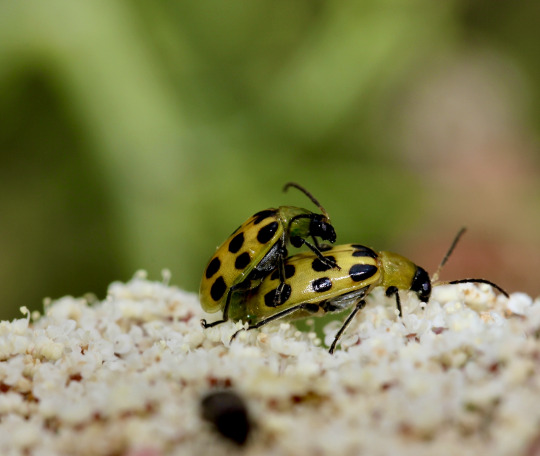#insect mating
Explore tagged Tumblr posts
Text



Turtle Beetles Mating.
#beetle#beetles#turtle beetle#turtle beetles#spiny turtle beetle#coleoptera#insect#insects#cassidinae#chrysomelidae#beetle mating#insect mating#mating#beetles of maharashtra#beetles of india#beetles of western ghats#biodiversity#western ghats
3 notes
·
View notes
Text

0 notes
Text

Mating desert bees By: John Alcock From: Natural History Magazine 1989
#mating cw#bee#hymenopteran#insect#arthropod#invertebrate#1989#1980s#John Alcock#Natural History Magazine
89 notes
·
View notes
Text


Bug of the Day
I HAVE QUESTIONS
😲
(Herpetogramma, 1.25 of them anyway)
#Herpetogramma#Crambidae#Lepidoptera#moth#insect#BotD#bug of the day#mating#failed mating#well it failed for at least one of them#I HAVE QUESTIONS
104 notes
·
View notes
Text
Happy Valentines Day



149 notes
·
View notes
Text
@onenicebugperday technically, this is 2 bugs but check this shit out:
The thrust momentum after they’re done…
#insects#yellowjackets#mating#mating season#holy shit#what am i watching#thrust#hips dont lie#nature
262 notes
·
View notes
Text








𓆸 Withering flowers, Blooming love ♡︎
#photographers on tumblr#my photography#original photographers#art#lensblr#photography#insect photography#wildlife photography#macro photography#nature photography#flower photography#nature#naturecore#insect#insects#butterfly#butterflies#lycaenidae#bugblr#entomology#bug#bugs#white flowers#butterfly sex#mating#so tiny#tinycore#august 21 2024#noai#no to generative ai
26 notes
·
View notes
Text










Common Red Soldier Beetle - Rhagonycha fulva
Just like a few years ago, a small section of partial wilderness in my neighborhood continues to play host to many mating pairs of Common Red Solider Beetle. When otherwise unoccupied, these diligent insects will crawl along and fly among the many flowers and buds here (including thistle buds). While some individuals are keen to hang around, dozens of individuals in this area were on patrol for soft-bodied insects to eat, such as small Caterpillars and Aphids. That in mind, the Plagiognathus Plant Bug specie seen in Pictures 1, 4 and 7 shouldn't let its guard down completely. This is of course, adult behavior, as the larvae of this Soldier Beetle feed on other plant-visiting animals such as hungry mollusks. As they visit flowers, it's worth mentioning that the diet of the adults also includes nectar and pollen, hence them diving headfirst into some of these flowers. Based on these pictures, I'm mindful of a point I brought in the previous point, where I wondered how/if these insects could serve as pollinating insects. Research supports that these Beetles play a role in pollination of certain flowers, but I wonder how that role varies across different types of flowers.
Flowers come in all shapes, sizes and configurations, and all area designed to work with some range of pollinators. So how might our Common Red friends here potentially pollinate the more open faced flowers and tipped thistle flowers in these images? The Beetle's bodies don't appear as suited for the adherence and transfer of pollen (compared to other pollinators), but they don't make direct contact with the flower's face. With how the insect travels, pollen may be transferred if some bits are caught on the Beetle's feet or from their mandibles as they go in for a nectar reward. Honestly, I think I'll need to revisit these Beetles next year when they return during the summer months. When I do, I'll observe them more carefully and see where pollen collects along their body and see how it makes contact with another flower. Regretfully, while they were many to behold when I photographed them, there were far less 2 weeks later, as their adult lives aren't long. Do not misunderstand however, these Beetles can be seen as adults all summer long, so some individuals may be airborne for a month or so, and securing mates when possible. And as it was before, the females continue to be distinctly larger than the males.
Pictures were taken on July 1, 2024 with a Google Pixel 4.
#jonny’s insect catalogue#ontario insect#beetle#common red soldier beetle#soldier beetle#coleoptera#insect#toronto#july2024#2024#mating pair#nature#entomology#invertebrates#arthropods#photography#animals#plagiognathus#plagiognathus plant bug#plagiognathus bug
10 notes
·
View notes
Text



Just two butterflies doin like they do on the discovery channel
#butterflies#lepidoptera#buetterflies mating#mating#nature#bug posting#entymology#entomology#my photography#insects#bug girl#bugs#insect#insecta#bug of the day#discovery channel#david attenborough
22 notes
·
View notes
Text

Made some Sleep Token bracelets today to help me deal with The Horrors™
#my mate has a matching 'funeral pyre' one as well!#the Alkaline and Winged Insect ones are remakes from a while ago because I got more beads and wanted to mix em' up a bit#also thinking about making bracelets for the concert in December...#so little time and so little beads 😭#sleep token#st#mel's photos#alkaline#song take me back to eden#take me back to eden#blood sport#bracelets
35 notes
·
View notes
Text


Blue Mormon Mating. Blue Mormon - The State Butterfly of Maharashtra (India).
#blue mormon#mormon#butterfly#blue mormon butterfly#butterflies#insects#entomology#lepidoptera#bugblr#invertebrates#arthropods#butterflies of tumblr#insects of tumblr#state butterfly#maharashtra#maharashtra state butterfly#wildlife photography#wildlife#nature#biodiversity#blue mormon mating#butterfly mating#mating#animal behaviour
34 notes
·
View notes
Photo

Carlin’s Mining Bees (Andrena carlini)
March 17, 2023
Southeastern Pennsylvania
#bee#bees#photographers on tumblr#bug#bugs#beeblr#bugblr#hymenoptera#Andrena carlini#carlin's mining bee#mating bees#nature#animals#insect#insects#entomology
156 notes
·
View notes
Text

Mating metalmarks By: Gary N. Ross From: Natural History Magazine 1985
#mating cw#metalmark#butterfly#insect#arthropod#invertebrate#1985#1980s#Gary N. Ross#Natural History Magazine
85 notes
·
View notes
Text


Na folha (On the leaf) © Ricardo Félix aka Photography is Silence Fiction:
#ricardo felix#original photogragphers#original art#photographers on tumblr#insect#bug#mating#green#red#nature
15 notes
·
View notes
Text
my favorite bit for grimmnet is hornet telling grimm, very seriously, how she's going to eat him after they fuck (as many insect species do). he doesn't believe her and then he gets nearly eaten in the afterglow
#h.text#i don't think it's an instinctual thing bc not all insects do it even among the kinds that do it#a female praying mantis may or may not eat her mate#or may eat one and not another#so i think it's more decision based and not really frowned upon in deepnest given cannibalism is a common part of life anyways#but i think grimm thinks she's bluffing or joking but she decides actually she would like a snack and he can live with a chunk out of him#those r my thoughts thank u
7 notes
·
View notes
Text

Short-horned grasshoppers (Rhytidochrota risaraldae) mating
By Charles Sharp
#charles sharp#photographer#flickr#short-horned grasshopper#grasshopper#insect#mating#rhytidochrota risaraldae#nature
14 notes
·
View notes